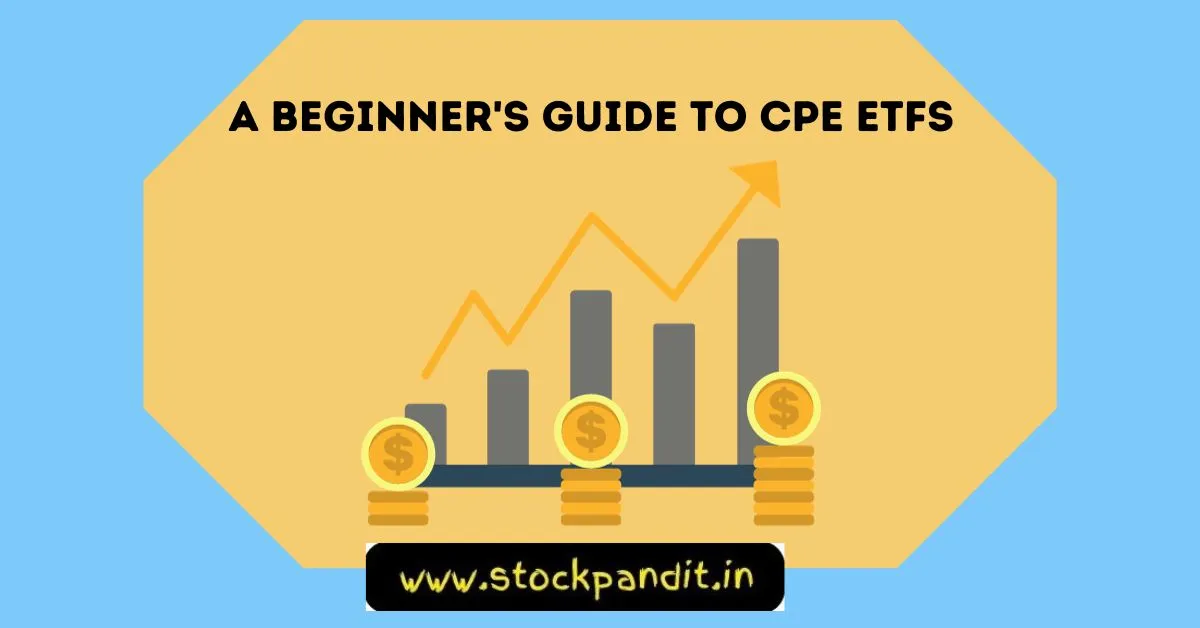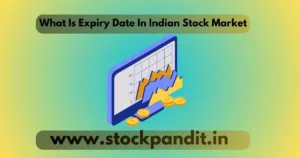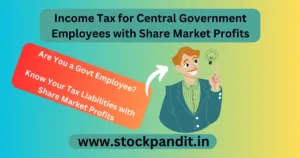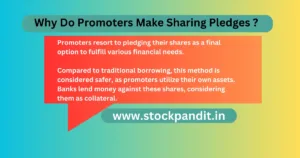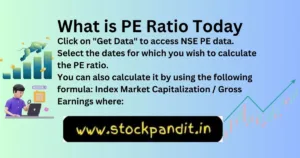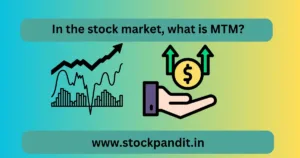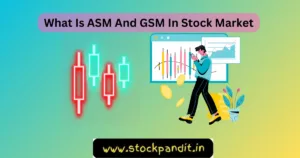What is CPSE ETF: CPSE ETF is a great option for investors who are looking to diversify their portfolios in a rewarding and unique way.
This blog will explain what What is CPSE ETF-10 Reasons to Invest in a CSE ETF is, how it functions, its benefits and risks, as well as why it is gaining in popularity with both seasoned and new investors.
Let’s first understand what the CPSE means. CPSE stands for companies that are owned and operated directly by the Indian Government.
The Government of India created the CPSE ETF to provide investors with a way to invest in a basket of public sector companies.
This investment option offers many benefits and is in line with the government’s drive towards disinvestment.
A Beginner’s Guide to CPSE ETFs
Central Public Sector Enterprises Exchange Traded Fund is the full name of Nifty CPSE. Investors can buy shares of Central Public Sector Enterprises through this unique financial instrument.
The ETF is an exchange-traded product, which means that it can be traded on stock markets just like stocks. The CPSE ETF forms part of the government’s disinvestment plan.
Which aims to generate more than Rs1 lakh cr through the sale its shares of various Public Sector Units PSU Stock.
Investors can benefit from the Central Public Sector Enterprises Exchange Traded Fund (ETF) concept of diversification, transparency, and cost-effectiveness. Investors can spread the risks associated with investing by investing in a CPSE ETF.
This allows them to gain exposure across a variety of public sector companies in different sectors. Diversification helps to reduce the volatility of individual stocks.
Nifty CPSE ETF has the advantage of being passively managed.
The fund’s portfolio is designed to mimic the composition of a benchmark index such as the CPSE Index. fund managers are responsible for ensuring that the ETF closely tracks the index to which it is linked. It is a low-maintenance option for investing.
You May Also Like: EBITA Meaning in Finance-5 Important Points
Top 10 Stocks Holding in CPSE ETF Portfolio
| Serial No. | Stocks Invested in | Sector | Value | % of Top Holdings |
| 1 | National Thermal Power Corp Ltd | Power Generation | 48635.7 | 21.53% |
| 2 | Power Grid Corp of India Ltd | Power Generation | 49644.9 | 19.74% |
| 3 | Oil and Natural Gas Corp Ltd | Oil Exploration & Production | 44730 | 19.80% |
| 4 | Coal India Ltd | Coal | 43783.5 | 17.41% |
| 5 | Bharat Electronics Ltd | Aerospace & Defense | 32221.2 | 12.81% |
| 6 | NHPC Ltd | Power Generation | 9314.7 | 3.70% |
| 7 | Oil India Ltd | Oil Exploration & Production | 6956.3 | 2.77% |
| 8 | SJVN Ltd | Power Generation | 3365.7 | 1.34% |
| 9 | NBCC (India) Ltd | Civil construction | 2602.6 | 1.03% |
| 10 | Cochin Shipyard Ltd | Ship Building & Allied Services | 2507.1 | 1.00% |
Please note: The data on the top CPSE-ETFs in India is from October 2023. Check the latest updated data for live updates on market trends and stock prices.
How to Understand the History and Inception of CPSE ETFs in India
India’s Government introduced the idea of a Central Public Sector Enterprises Exchange Traded Fund as part of its disinvestment strategy to unlock value for its public sector company holdings.
The Department of Disinvestment (now known as the Department of Investment and Public Asset Management, DIPAM) launched the first CPSE ETF in March 2014, known as “CPSE ETF 2014”.
Investors were pleased with the CPSE ETF 2014. It offered a way to invest in India’s top public sector companies through a single transaction.
CPSE ETF was launched in successive tranches, including CPSE ETF 2017, and CPSE ETF 2019. Each of these included a different set of CPSEs.
The government was encouraged by the success of the Central Public Sector Enterprises Exchange Traded Fund to explore other disinvestment options through ETFs.
The government introduced sector-specific ETFs such as Bharat 22, which is a mix between CPSEs and public sector banks.
Unleash the Potential of CPE ETFs
The CPSE funds are flexible options for investment with no holding period. Investors can trade units at stock exchanges with a minimal purchase of 1 unit. This gives exposure to CPSE stocks within the NIFTY CPSE Index.
Currently, approximately 98.6% is invested in equities and the rest is liquid securities. Over 75% of the CPSE ETF’s equity is invested in large-cap companies, and around 20% in mid-cap companies.
The CPSE ETF has a notable concentration, mainly within the oil and gas and power sectors. NTPC Power Grid Corp and ONGC, each account for nearly 20% of the CPSE ETF portfolio.
CPSE ETFs are passive funds and have the lowest expense ratio in the industry, currently at 0.05%. This compares to a typical mutual fund with a 2% expense rate.
Comparing ETFs and Investment Options: A Comprehensive Guide
Compare the Central Public Sector Enterprises Exchange Traded Fund with other ETFs, and then compare that to traditional investment options.
While traditional ETFs track various market indices and other investment options, CPSE ETF focuses solely on the performance of government-owned firms.
CPSE ETFs have generally lower expense ratios than actively managed mutual funds due to their passive style of management.
Investors who are looking for cost-effective options to invest in while also hoping to gain from market growth can benefit from this.
CPSE ETF shares offer diversification advantages when compared with investing in CPSE stocks individually. It spreads out the investment over multiple companies. Diversification reduces the impact of poor performance by a single CPSE.
Central Public Sector Enterprises Exchange Traded Funds are not without their own risks. The performance of this fund has directly influenced the performance of CPSEs.
ETF returns can be affected by factors that affect the public sector such as government policy and economic conditions.
Who Can Benefit from CPE ETFs ?
The underlying assets of the CPSE ETFs are the various stocks of (CPSEs). These CPSEs, which are government-owned, play a vital role in India’s economic system.
They operate across diverse sectors such as banking and infrastructure. Among the CPSEs in the CPSE ETF are well-known companies like ONGC (Oil and Natural Gas Corporation), NTPC, Coal India and others.
The performance of CPSE ETF shares is closely linked to the combined performance of these CPSE stocks.
As an investor, you hold shares in all companies in the ETF portfolio. You enjoy the benefits and risks associated with these investments.
You May Also Like: What is The Book Value of a Share
How to Utilize the Government of India’s Role in CPE ET
The Government of India and specifically the Department of Investment and Public Asset Management, (DIPAM) plays a crucial role in managing Central Public Sector Enterprises Exchange Traded Funds.
DIPAM has the responsibility of creating and launching CPSE ETFs, as well as deciding the portfolio composition. The government aims to raise funds by disinvesting its shares in CPSEs through the ETF route.
Because the government continues to hold Nifty CPSE ETFs, it is still invested in the performance and profitability of CPSEs. The government is therefore interested in the growth and profitability of these public-sector companies.
Exploring the Creation and Redemption Mechanism of Central Public Sector Enterprises Exchange-Tr
It is a feature that only ETFs can offer, and this includes CPSE ETFs. This allows units to be available in the market continuously and ensures that the CPSE-ETF price closely matches its net asset value.
Creation When launching an ETF, a participant authorized, usually a large financial institution, or broker, will work with the ETF’s issuer (in the case of this ETF, the government), to create new ETF units.
The ETF is created by purchasing a basket of underlying assets in the same proportions as the ETF. The new units are made available to trade on the stock market.
Redemption When an investor wants to get out of their ETF position, they can redeem their units. It is the same process as creation but reversed.
The investor sells his ETF units to the public on the stock market, and then the ETF issuer buys them back from him in exchange for CPSE stocks.
Exploring the Benefits of Investing in CSE ETFs
Diversification is one of the biggest advantages that CPSE ETF offers investors. The ETF (Exchange-Traded Fund is the full name of the ETF) distributes investment risk by holding a basket containing stocks from different CPSEs.
Diversification reduces the impact of a single company’s poor performance. This provides a more stable option than investing in individual stocks.
CPSE ETF also includes companies from different industries. These include energy, banking and finance, power and more. This increases diversification and exposure across different sectors of the economy.
Diversification is especially useful for investors who want to take a balanced risk management approach.
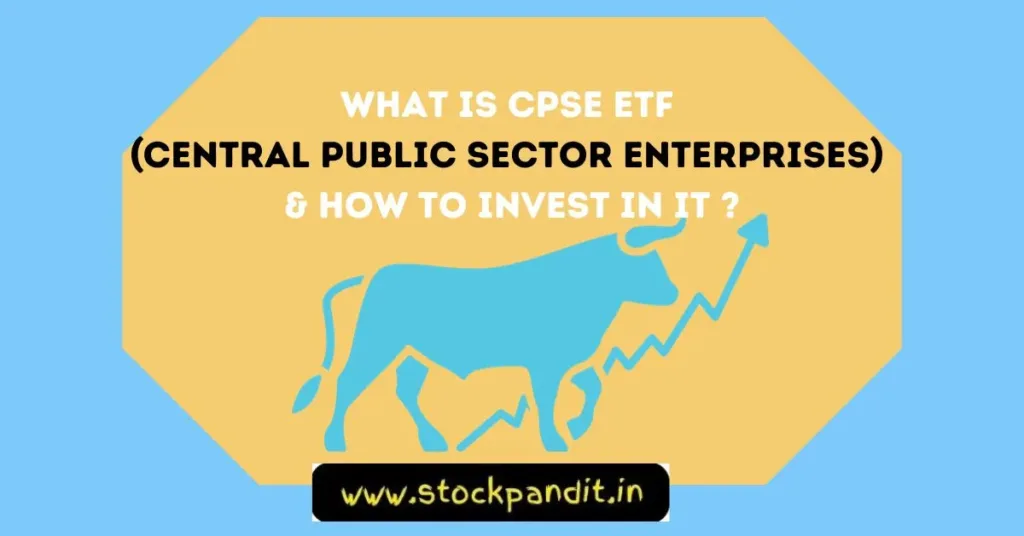
CPE ETF: Achieving Low Expense Ratios and Cost-Effect
CPSE ETFs have passive management, meaning they are not actively traded. They aim to mimic the performance of a particular index by replicating it without buying and selling assets frequently.
CPSE ETFs have lower management fees and expenses than actively managed funds. The cost-effectiveness of CPSE ETF constituents allows investors to keep a larger proportion of their return, maximising the potential gain from their investment.
CPSE ETFs are attractive investments due to their efficiency and structure. They also have relatively low expense ratios. They are therefore a good choice for investors who want to maximize their long-term returns.
Exploring the Benefits of Liquidity and Tradability
Central Public Sector Enterprises Exchange Traded Funds (CPSE ETFs) are listed on stock exchanges and traded, giving investors an advantage in terms of liquidity.
The units of traditional mutual funds are purchased and redeemed from the fund house. Investors can therefore buy and sell CPSE ETF Units on the exchange during trading hours at current market prices.
Using this feature, investors can enter and exit positions at any time. This is all without any lock-in period. Investors can have greater control of their investments by trading in real time.
This gives them the flexibility to change their portfolio in response to market changes or personal financial goals.
The Impact of Stable Returns on the Long-Term
CPSE ETFs consist of shares in well-known and established Central Public Sector Enterprises that have a significant presence in India’s economy.
These CPSE ETFs have a history of stable performance, and they may pay regular dividends to their shareholders.
CPSE ETFs can generate stable returns over the long term, particularly when underlying CPSEs are performing well. CPSE ETFs can also benefit from the government’s efforts to boost growth and efficiency within the public sector.
CPSE ETFs are a good option for investors who have a long-term investment horizon. They can offer a good balance between stability and growth potential.
Uncovering the Secrets of CPSE ETFs: A Historical Analysis
We can look at the past trends in some of the main NSE CPSEETF to know the historical performance of CPSE ETF. We can analyze the performance of the various tranches launched by the government in the past.
We can, for example, look at the performance of the first CPSE ETF, launched in 2014. As well as the subsequent tranches, such as Central Public Sector Enterprises Exchange Traded Fund 2017, and CPSE ETF 2019.
We can also evaluate the performance. We can evaluate the performance of these ETFs by analyzing their returns and fluctuations of NAV (Net Asset Values).
You May Also Like: How to Invest in Nifty 50 ETF 2024
Analyzing the Impact of Past Trends and Returns
It’s important to take into account both the short-term and the long-term performance when analyzing historical CPSE ETFs.
Market sentiment and macroeconomics can influence short-term fluctuations. Long-term performance provides insight into the sustainability and potential of ETFs.
Imagine, for example, that we look at the performance of Central Public Sector Enterprises Exchange Traded Funds over the last five years.
These ETFs may have seen periods of growth and corrections. Even volatility is caused by changing market conditions.
By analyzing such trends, investors can better understand the typical behaviour of CPSE-ETFs and make better investment decisions.
The Impact of CPE ETFs on Performance
CPSE ETF performance and share price can be affected by several factors. Investors must understand these factors to be able to evaluate the risks and rewards of investing in ETFs.
Market Condition: Overall health of the stock market, and the economy may have a significant impact on the performance of CPSE-ETFs.
These ETFs can show strong growth during bullish market phases. Bearish markets may lead to a correction in their NAV.
Performance of Sectors: The performance and profitability of the specific sectors that are represented in the CPSE portfolio can influence returns.
If the energy sector sees a rise in profitability and demand, this could have a positive impact on the ETF.
Government Policy: Government decisions and policies regarding economic reforms and sector-specific measures, as well as disinvestment and other government policies, can directly affect the CPSE ETF’s share price.
Favorable policies can boost the performance and value of these ETFs. Unfavorable decisions may lead to temporary setbacks.
Inflation and Interest Rates: The overall sentiment of the market and investor behavior can be affected by changes in inflation and interest rates.
This has an indirect impact on the performance of Central Public Sector Enterprises Exchange Traded Funds.
Global events: Geopolitical development and international events may cause ripples in the global financial market, impacting investor sentiment. The performance of Central Public Sector Enterprises Exchange Traded Funds is also affected.
Are There Risks Associated with Investing in CPE ETFs ?
Market Risks and Volatility
Like any investment in the stock market, Central Public Sector Enterprises Exchange-Traded Funds are exposed to market risks and fluctuations.
The overall performance of the stock market can influence the NAV of CPSE ETFs, leading to potential gains or losses for investors.
Market volatility, driven by economic conditions, geopolitical events, and investor sentiment, can result in rapid price movements, making it essential for investors to be prepared for short-term fluctuations.
Investors should be aware that the value of Central Public Sector Enterprises Exchange-Traded Fund units can rise or fall based on market conditions, and they should consider their risk tolerance before investing in such funds.
Sector-Specific Risks Associated with CPSE Stocks
Central Public Sector Enterprises Exchange-Traded Funds consist of stocks from various sectors, and the performance of these sectors can vary based on industry-specific factors.
For example, the energy sector’s performance might be influenced by fluctuations in crude oil prices, while the banking sector’s performance could be affected by interest rate changes and loan quality.
Investors should be cautious about concentrating their investments heavily in one sector, as it may lead to increased exposure to sector-specific risks. Diversification across different sectors can help mitigate this risk.
Government Policies and Regulatory Risks
Government policies and regulations can significantly impact CPSE ETF stocks. Decisions related to disinvestment, privatization, or changes in sector-specific policies can affect the performance of the underlying NSE CPSEETF and, consequently, the ETF’s returns.
Moreover, changes in tax laws or investment regulations could impact the taxation of capital gains on ETF units, affecting investors’ net returns. Investors should stay informed about government policies and their potential implications on CPSE ETF investments.
The importance of due diligence and risk management
Due diligence is essential when investing in Central Public Sector Enterprises Exchange Traded Funds. Investors must carefully examine the ETF’s performance in the past, its portfolio composition, the expense ratios and the expertise of its fund manager.
Before making an investment decision, it is important to understand your risk tolerance and goals. CPSE ETFs are suitable for investors who want to achieve long-term growth while taking on moderate risks, but others may choose other investment avenues.
To reduce risk and maximize potential returns, investors should consider diversifying their portfolio among different asset classes and industries.
Asset allocation can be based on financial goals, risk appetite and individual risk tolerance. This is a key factor in managing risk exposure.
A qualified financial advisor is also a great resource for making informed investment decisions that are aligned with your individual financial goals and circumstances.
In the next section, we will discuss how to maintain a CPSEETF Portfolio and invest in ETF CPSE.
A Beginner’s Guide to Investing in CSE ETFs
The step-by-step Guide to Investing in Central Public Sector Enterprises Exchange Traded Funds
Step 1 – Research and Assess
Start by researching CPSE ETFs. Understand their performance history, portfolio compositions, expense ratios and risk factors. Assess if investing in Central Public Sector Enterprises Exchange Traded Funds aligns with your goals and tolerance for risk.
Step 2 – Select the Right CPSE ETF
The market offers different Central Public Sector Enterprises Exchange Traded Funds. Choose the ETF that suits your investment goals. Take into account factors like the underlying CPSEs and sector exposure.
Step 3 – Open a Demat account
You need a Demat Account to invest in CPSE ETFs. You can open a Demat account at a financial institution or stockbroker if you do not have one. Make sure that your Demat account and bank account are linked for smooth transactions.
Step 4: Place your order
Log into your trading account to place an order for Central Public Sector Enterprises Exchange Traded Fund Units. Enter the quantity and price of the units that you would like to purchase.
Public Sector Enterprises Exchange Traded Funds trade on stock exchanges just like regular stocks.
Step 5: Monitor your investment
Keep an eye on the performance of Central Public Sector Enterprises Exchange Traded Funds once you’ve purchased them. Keep an eye on the market and changes to the CPSE ETF’s portfolio.
When Is the Best Time to Invest in CPE ETF Stock ?
Here are six important reasons why you should consider investing in CPSE ETFs.
- Individuals should consider their financial goals and tolerance for risk before deciding whether to invest in CPSE ETFs.
- These considerations are crucial, especially in light of possible fluctuations in CPSE ETF share prices.
- CPSE ETFs allow investors to diversify by gaining exposure across a variety of public sector companies (CPSEs). These CPSE ETFs span various sectors and offer investors a well-rounded opportunity for growth.
- CPSE ETFs are a great way to invest in India’s growing public sector. These ETFs were designed to reflect the performance of CPSEs and are therefore an attractive choice for those interested in this sector.
iv It is prudent to keep an eye on the CPSE ETF share prices since these can fluctuate based on market dynamics and the performance of the underlying CPSEs.
v Investors who want to make informed decisions about the purchase or sales of CPSE ETFs must monitor share prices consistently.
A Comprehensive Overview of Platforms and Exchanges for Investing
Investors can invest in Central Public Sector Enterprises Exchange Traded Funds through a variety of platforms and stock exchanges.
In India, most stockbrokers and other financial institutions offer ETF trading. This includes CPSE-ETFs on major stock exchanges such as NSE (National Stock Exchange), and BSE.
Stockbrokers provide online trading platforms and mobile applications that allow investors to easily buy and sell Central Public Sector Enterprises Exchange Traded Funds with just a few clicks.
These platforms allow investors to access information on the performance and composition NSE CPSE Exchange-Traded Fund.
Tax Implications and Considerations
Investors should consider the tax implications before investing in CPSE-based ETFs. Tax-wise, these are treated as equity-oriented funds.
STCG (Short-term Capital Gains): When you sell CPSE-ETF units within a year of purchasing them, the gains will be treated as short-term gains and subject to a 15% flat rate.
Long-term capital gains (LTCG): When you sell CPSE units within one year after purchase, and the gains are greater than Rs. If you sell CPSE ETF units after one year of purchase and the gains exceed Rs.
Dividends Central Public Sector Enterprises Exchange Traded Funds can also declare dividends that are tax-free for investors. The fund house will deduct the Dividend Distribution Tax before distributing the dividends.
Tax-Saving Investments: Investors are advised that CPSE ETFs will not qualify as tax-saving investments under Section 80C Income Tax Act. They are considered to be regular equity investments.
Consult a financial or tax expert to better understand your tax situation.
A Closer Look at the Current Market Outlook and Future Prospects of CPE ETFs
The market outlook for CPSE ETF is positive, especially given the government’s continued focus on reforms and disinvestment.
CPSE ETFs are expected to perform well as the economy grows and the government improves the efficiency and profitability for CPSEs.
CPSE ETF offers diversification and stable returns for investors who are looking to invest in various sectors.
Uncovering the Factors Influencing CPS ETF Performance in the Coming Years
In the future, the performance of Central Public Sector Enterprises Exchange Traded Funds will be influenced by several factors:
Government initiatives: Government policies relating to disinvestment and privatization as well as reforms within the public sector are key factors in determining the performance of CPSE ETF shares.
Investor sentiment will be influenced if the government is committed to enhancing the efficiency and value of CPSEs.
Economic growth: Overall economic growth in a country can significantly impact the performance of CPSE. A robust economic growth is usually favourable for the profitability and performance of public sector firms.
Sectoral performance: Performance of the specific sectors in the CPSE share portfolio is a major driver of returns. Investors should monitor closely the growth prospects of these sectors and their challenges.
Global factors: Geopolitical trends and global economic trends may also affect investor sentiment. Capital flows into Central Public Sector Enterprises Exchange Traded Funds.
Investors must remain vigilant and informed of these factors in order to make an informed decision about their investment in CPSE-ETFs.
While CPSE ETFs offer attractive opportunities, investors must always keep a long-term outlook. Be prepared for short-term changes.
FAQs
What is the difference between Bharat ETF & CPSE ETF ?
CPSE ETF versus Bharat 22
Investors tend to confuse the CPSE ETF with the Bharat 22, but this is not the case. Both are passive ETFs that the government has floated, but there is a small difference. The CPSE ETF only has 10 Navaratnas in its portfolio.
What does CPSEETF stand for ?
Central Public Sector Enterprises Exchange Traded Fund is the full name of CPSE in economics.
Is CPSE ETF a safe investment ?
According to SEBI’s new guidelines for calculating risk categories, investments in the CPSE ETF fall under Very high risk category.
What is a CPSE Exchange Traded Fund ?
A CPSE ETF is a type of exchange-traded fund that invests shares in public sector companies owned and controlled by the Indian Government.
What is the growth of CPSE ETF ?
CPSE ETF Growth is the growth in value of the CPSE ETF. This is a measure for how well the ETF performed on the stock market.
Does CPSE ETF have a tax-free status ?
Tax Benefits from Investment in CPSE ETF
Currently, investment up to Rs1.5 lakhs in ELSS is eligible for tax deductions based on Section 80(C).
Is CPSE ETF taxable or not ?
Yes, CPSE ETFs are taxable just like other investments. Capital gains on the sale of CPSE ETFs are taxed, and dividends are taxed according to the tax slabs of the investors.
Why ETFs are not popular in India ?
ETFs in India are relatively new and investors do not know their advantages and disadvantages.
Who is the best investor for CPSE ETF constituents ?
Investors who are interested in dividend income and long-term growth should invest in CPSE ETF components.
What is the best investment for CPSE ETF ?
Financial experts recommend CPSE ETFs as a valuable avenue for investment, recognizing their potential for growth on a long-term basis and government-backed security.
These stocks may see further value unlocking as the government continues to disinvest and reform the public sector.
Do we get dividends in ETF ?
ETFs distribute dividends from stocks that are held by the ETF. ETFs that receive dividends are required to pay them in cash or by issuing additional shares.
Dividends can be taxed either at the long-term gains tax rate or at the ordinary income tax rate of the investor.
Is the CPSE ETF a good investment ?
The CPSE ETF in its full form can be a great investment for investors looking for a low-cost, diversified exposure to Indian stocks. Investors should understand the risks before investing in a CPSE ETF.
Is ETF under 80C ?
Now, individuals can invest in Central Public Sector Enterprises Exchange-traded Fund (ETF) to get a tax deduction under Section 80C of the Income Tax Act just as they do in equity-linked saving schemes (ELSS).
